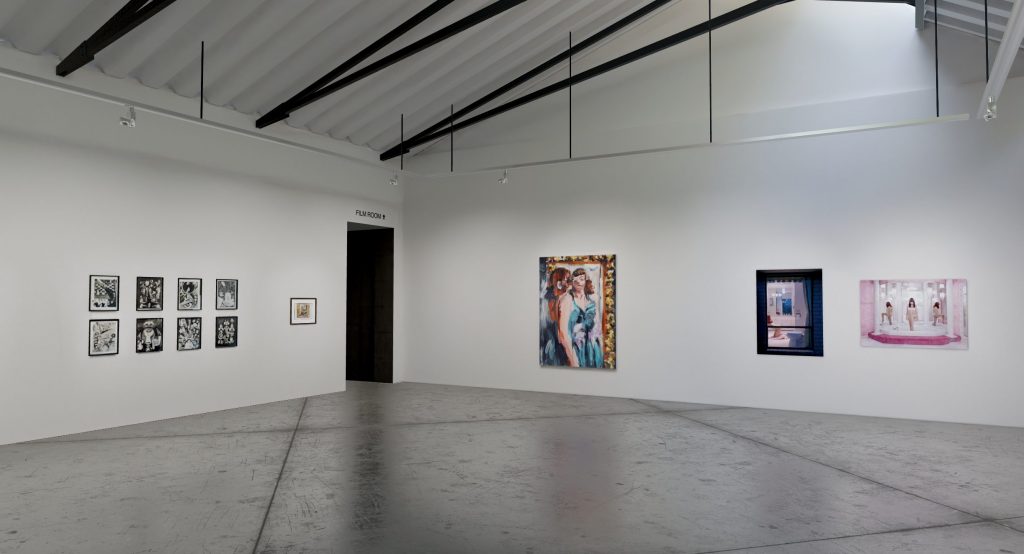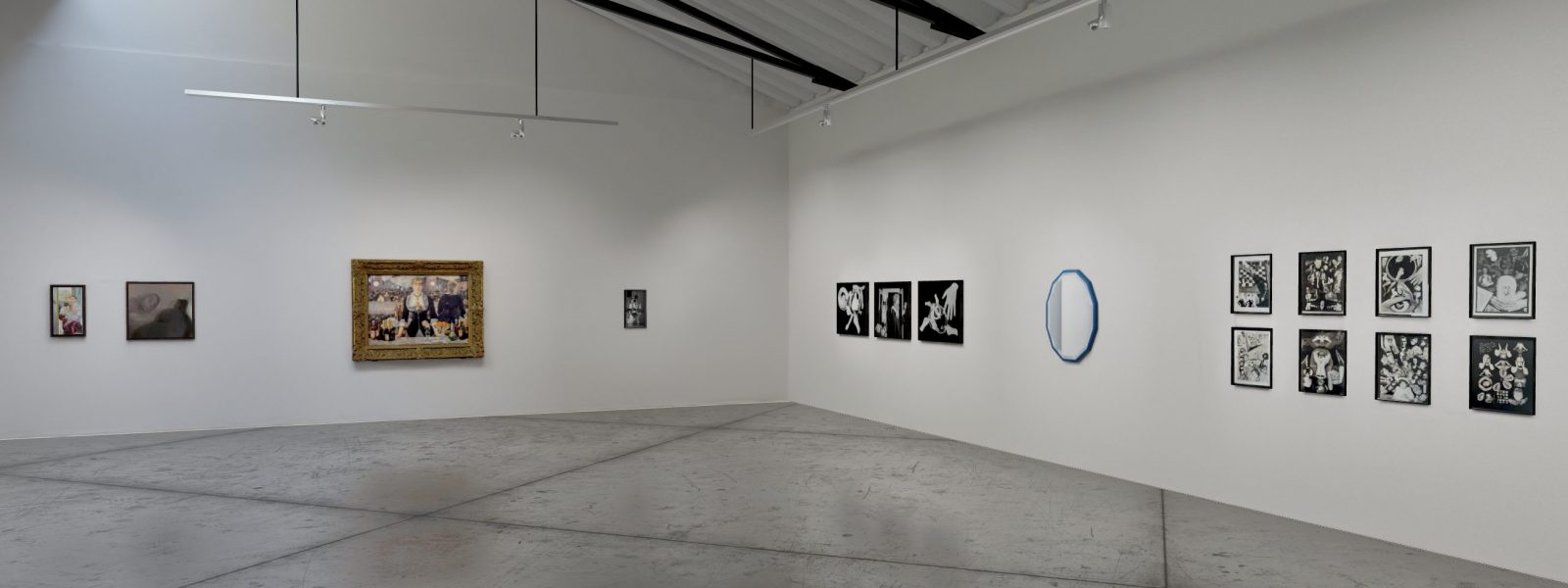Vortic Curated Views – Mirror, Mirror on the Wall, by Francesca Gavin
The mirror is the watershed object of visual art. From Van Eyck’s concave mirror in The Arnolfini Portrait to Velasquez’s Las Meninas, the representation of mirrors and reflection marks the moment when art became aware of itself. When the painting was seen as not just a straight representation of the Truth, God or life but was something more complex and multifaceted. Art became an object of metaphor and worldliness.
The painting that took this even further in the modern world was Édouard Manet’s A Bar at the Folies-Bergère, the work at the heart of Beth Greenacre’s exhibition I’ll be Your Mirror.

Manet’s painting, which hangs in London’s Courtauld collection, has been the focus of admiration and conversation since its creation in 1882.
Writers from Georges Bataille to Michel Foucault to Linda Nochlin have tried to unpick its take on composition, politics and most centrally the role of the mirror at the heart of the work.
Manet’s last major painting depicts a barmaid at the notorious fashionable Parisian night spot, the Folies-Bergère. She is surrounded by alcohol bottles and standing in front of a mirror. In the mirror, we are presented with a distorted reflection of what appears to be a financial transaction at the bar. The compositional experimentation of the painting, as much as the ambiguous narrative, made it one of the most iconic paintings of the era.
A Bar at the Folies-Bergère presented a new way of depicting the contemporary and its socio-political context. “A sly, underhand moral complacency weighs heavy on this picture” Georges Bataille enthused in his biography of the artist in 1955. Manet presented a new way of viewing the female subject not just as an object to be consumed but as active. Here, the female gaze was direct, confronting, bored, accusatory, revealing. Foucault described the female figure as “the great distortion”. Everything sitting on the bar in front of the mirror is reproduced in its reflection but altered, so that we inhabit the position of the painter-male figure at the bar.
The painting was made in the 19th century context of sex work and syphilis, shifting class relationships and mass consumption. Art historian TJ Clark saw the painting as one of the first works about modern class relationships between the working class and the bourgeois. Here the mirror reflects the self-aware bourgeoisie.
The viewer is in more than one place at once – a weird compressed space close and removed to the subject. We the viewer-consumer is reflected in the mirror and outside it. The angles echo the movements of the painter, the shifting gaze of lived experience. In a Lacanian context, the painting demonstrates the split between the eye and the gaze.
A painting depicting a doubling – between the psychological and the physical experience.
I’ll be Your Mirror has the rare chance to place Manet in equal contrast to other works. The exhibition highlights how reflection and mirroring has enabled artists to explore themselves, their environment and the position of the viewer. These artists have used mirrors as a motif or material touch on mirroring’s complexity in terms of identity, subjectivity and defining reality.

Curator Beth Greenacre’s selection of artists is trans-historical and trans-generational.
The selected work by Robert Longo most directly addresses Manet’s piece with his 2017 charcoal drawing based on an X-ray of the painting, Untitled (X-Ray of A Bar at the Folies-Bergere, 1882, After Manet). Longo exaggerates and expands Manet’s chiaroscuro, slowing down the photographic reproduction of the painting into something intimate and deeper. The central figure’s eyes are transformed into dark rings. The curved sweeps of Manet’s brushstrokes exaggerated. Longo highlights the sense of movement in the mirrored reflection. Viewing the work in 3D allows access to the framed work from above or an extreme side angle. Here the mirror is not static but in flux.

One of the central ways artists have addressed the mirror is as a reflection of self.
Celia Paul’s painting My Mother Looking in the Mirror (1999) is the most sensitive and emotive piece in the show. Here the subject is lying down, staring into a hand-held mirror as if searching for their identity. Laura Lancaster’s viscerally painted female subject stands upright against a mirror, leaning into their own reflection. Juno Calypso’s subject is seen voyeuristically through a window in a mirrored bathroom Head First Into The Future (2018), appearing to kneel into their reflection. In these works, the female subjects look at the mirror for confirmation, subjectivity, meaning. Here the mirror is a metaphor for the gaze directed at a female subject. It is in reflection that these subjects exist.

Another approach of the mirror is more playful and confrontational.
Claude Cahun’s experimental photo-collages use mirroring and repetition as a technique. Here reflection and reproduction push ideas around masking and identity. Sarah Pucill’s monochrome odes to Cahun’s surreal montages incorporate the hand mirror itself as a motif. Here the handheld object is layered and multi-faceted. Like Manet’s painting, we see multiple viewpoints at the same time. We are aware of the mirror as a tool as much as an represented object. These takes on self-portraiture are both active and receptive. In Camille Billops and Christopher Page’s works, the mirror becomes the subject in its own right. The clean slate of its glass surface is untouched by image. We are presented with a void, ready to be activated. Page’s work is a reproduction of an image while Billops is a ceramic work containing a mirror itself. Here the mirror is nothingness and truth simultaneously.
In this exhibition art historical legacy of the mirror emerges against the contemporary everyday relationship to reflected surfaces, from the wardrobe mirror to the black mirror of a phone screen. Mirroring echoes the experience of technology – making it a notably apt topic for a 3D, AR and VR exhibition. Here artworks are seen dynamically. The pieces interact and refract. They can be seen at multiple angles as the gaze moves. Like light and image hitting a mirror, there is not a single vantage point. Instead, we are presented with the oblique alongside the obvious.
The mirror is an active surface throwing back the gaze and ideas back at us as viewers. It invites us to reflect.

Credits: Edouard Manet, A Bar at the Folies-Bergere, 1882. Courtesy of The Courtauld. Laura Lancaster, Living all over me, 2023. Courtesy of the artist and David Lawson Commercial Photography. María Berrío, Self Portrait in Venice, 2023. Courtesy of the artist and Victoria Miro Gallery. Camille Billops, Untitled (Checkered), 2003. Courtesy of the artist and Ryan Lee Gallery. Claude Cahun, Avant de renoncer au monde je danserai devant Hérode, par ce qu’il s’intéresse à mon sommeil et qu’il a su m’inciter à retracer mes pas, à renfiler mes songes, c. 1930s. Courtesy of the artist and Michael Hoppen Gallery. Juno Calypso, A Clone of your Own, 2017. Courtesy of the artist and Hannah Watson Gallery. Alexis Hunter, Self-Portrait, 1977/2010. Courtesy of the artist and Richard Saltoun. Laura Lancaster, Living all over me, 2023. Courtesy of the artist and David Lawson Commercial Photography. Robert Longo, Untitled (X-Ray of A Bar at the Folies-Bergere, 1882, After Manet), 2017. Courtesy of the artist and Thaddaeus Ropac. Bex Massey, Invert 2, 2022. Courtesy of the artist. Christopher Page, Interion, Still Remains, 2022. Courtesy of the artist and Ben Hunter Gallery. Celia Paul, My Mother Looking in the Mirror, 1999. Courtesy the artist and Victoria Miro Gallery. Sarah Pucill, Handmirror, 2013. Courtesy of the artist. Paula Rego, Princess Diana and her Two Boys, 2014. Courtesy of the artist and Victoria Miro Gallery.




